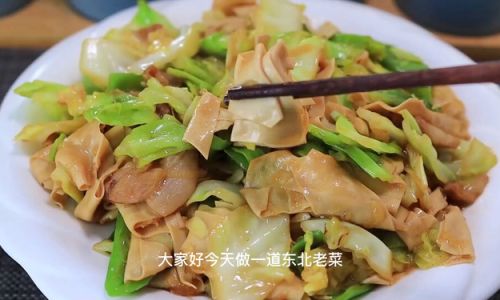Introduction
Stir-fried cabbage with dried tofu, a humble yet deeply satisfying dish, is a staple in many households across Asia. This recipe combines the crisp texture of fresh cabbage with the chewy, absorbent nature of dried tofu, creating a harmonious blend of flavors and textures. Often served as a side dish or a light main course, it is celebrated for its simplicity, affordability, and nutritional value. Whether you are a seasoned home cook or a novice in the kitchen, mastering this dish will add a versatile and wholesome option to your culinary repertoire. In this guide, we will explore the step-by-step process of creating this beloved dish, from selecting the finest ingredients to perfecting the cooking technique.

The Allure of Stir-Fried Cabbage and Dried Tofu
Before diving into the recipe, it is worth understanding why this dish has stood the test of time. Cabbage, a cruciferous vegetable, is rich in fiber, vitamins, and antioxidants, while dried tofu (also known as dried bean curd or doufu gan in Chinese) offers a plant-based protein boost with a unique meaty texture. Together, they form a balanced meal that is both nourishing and comforting. The dish’s appeal also lies in its adaptability—it can be spiced up with chili, enriched with garlic, or lightened with a splash of vinegar, depending on your palate.
Ingredients: Building Blocks of Flavor
To recreate this dish authentically, gather the following ingredients:
- Cabbage (1 medium head): Opt for a firm, green cabbage with crisp leaves. Avoid wilted or overly soft specimens, as they will release excess moisture during cooking.
- Dried tofu (150g): This ingredient, available in most Asian grocery stores, is sold in thin, beige sheets. It has a dense texture and absorbs flavors beautifully.
- Garlic (3 cloves): Fresh garlic adds a pungent aroma and depth of flavor.
- Ginger (1-inch piece): A small knob of fresh ginger complements the cabbage’s earthiness.
- Scallions (2 stalks): These will be used for garnish, adding a fresh, oniony finish.
- Cooking oil (2 tbsp): Use a neutral oil like vegetable or canola oil to avoid overpowering the dish.
- Soy sauce (1 tbsp): Opt for light soy sauce for salinity without darkening the dish excessively.
- Oyster sauce (1 tsp, optional): For an umami-rich twist, though vegetarians can skip this.
- Salt and white pepper (to taste): Adjust according to preference.
- Sesame oil (1/2 tsp): A finishing touch for aromatic complexity.
Preparation: The Foundation of a Great Dish
-
Prepping the Cabbage:
- Remove any damaged outer leaves and rinse the cabbage under cold water.
- Slice the cabbage into quarters, then shred each quarter into 1/4-inch strips. Ensure uniformity for even cooking.
- Pat the shredded cabbage dry with a clean kitchen towel to prevent sogginess.
-
Preparing the Dried Tofu:
- Rinse the dried tofu under warm water to remove excess salt (if packaged).
- Slice it into thin strips or bite-sized squares. For added texture, lightly press the tofu between paper towels to absorb moisture.
-
Aromatics:

- Mince the garlic and ginger finely.
- Chop the scallions, separating the white and green parts. The white portions will be sautéed with the aromatics, while the green parts are reserved for garnish.
Cooking Process: Mastering the Stir-Fry
Stir-frying is a high-heat cooking method that sears ingredients quickly, preserving their crispness and vibrancy. Follow these steps for optimal results:
-
Heating the Wok:
- Place a wok or large skillet over high heat. Allow it to smoke lightly—this ensures the ingredients will sear rather than steam.
- Add the cooking oil and swirl to coat the pan evenly.
-
Sautéing Aromatics:
- Reduce the heat to medium-high and add the minced garlic, ginger, and white scallion parts.
- Stir-fry for 30 seconds until fragrant, taking care not to burn the garlic.
-
Cooking the Dried Tofu:
Toss the prepared tofu into the wok. Stir-fry for 2-3 minutes until lightly golden. The tofu will absorb the oil and aromatics, developing a rich flavor.
-
Adding the Cabbage:

- Increase the heat to high and add the shredded cabbage. Use tongs or a spatula to toss it continuously, ensuring even cooking.
- Stir-fry for 4-5 minutes until the cabbage wilts slightly but retains its crunch. Overcooking will result in a mushy texture.
-
Seasoning the Dish:
- Drizzle the soy sauce and oyster sauce (if using) over the mixture. Toss to coat evenly.
- Season with salt and white pepper. Adjust to taste, keeping in mind that dried tofu can be slightly salty.
-
Finishing Touches:
- Drizzle sesame oil over the dish and toss once more.
- Remove from heat and transfer to a serving platter. Garnish with the reserved scallion greens.
Tips for Perfect Stir-Fried Cabbage and Dried Tofu
- Control Moisture: Excess liquid is the enemy of a good stir-fry. Ensure the cabbage and tofu are as dry as possible before cooking.
- High Heat is Key: A searing-hot wok ensures the ingredients cook quickly without steaming. Invest in a sturdy wok if you plan to stir-fry regularly.
- Timing is Everything: Cook the cabbage just until it wilts—it should still offer resistance when bitten.
- Customize the Flavor: Experiment with additions like chili flakes, a splash of rice vinegar, or a pinch of five-spice powder for depth.
- Protein Boost: For a heartier meal, add sliced mushrooms, shredded chicken, or shrimp during the cooking process.
Variations and Creative Twists
While the classic recipe is a treasure, feel free to explore these variations:
- Spicy Version: Add dried red chilies or a dollop of chili paste during the aromatics stage.
- Vegetarian Delight: Swap oyster sauce with hoisin sauce or mushroom-based seasoning for a plant-based twist.
- Noodle Stir-Fry: Toss cooked noodles into the mix during the final minutes for a one-pot meal.
- Fermented Flavors: A splash of black vinegar or a spoonful of fermented bean paste can introduce tangy complexity.
Serving Suggestions
This dish pairs wonderfully with:
- Steamed Rice: The classic accompaniment that soaks up the dish’s savory juices.
- Congee: A comforting rice porridge, especially during colder months.
- Fried Rice or Noodles: Elevate leftovers by incorporating them into a larger meal.
- Asian-Inspired Bowls: Layer it over quinoa or brown rice with a soft-boiled egg for a modern twist.
Health Benefits: Nutrition in Every Bite
Beyond its delicious taste, this dish is a nutritional powerhouse. Cabbage is low in calories but high in vitamins C and K, while dried tofu provides calcium and iron. The dish is also naturally gluten-free (ensure your soy sauce is certified gluten-free if needed) and can be adapted to suit vegan diets.

Troubleshooting Common Issues
- Soggy Cabbage: Ensure the cabbage is dry before cooking and avoid overcrowding the pan.
- Bland Flavor: Amplify seasonings gradually, tasting as you go. Fresh aromatics like ginger and garlic can rescue a dull dish.
- Burnt Aromatics: Keep heat at medium-high when sautéing garlic and ginger to prevent scorching.
Conclusion: A Dish That Transcends Borders
Stir-fried cabbage with dried tofu is more than a meal—it is a testament to the beauty of simplicity. With its balance of textures, flavors, and nutrients, it embodies the philosophy of wholesome home cooking. Whether you are cooking for one or a crowd, this dish delivers satisfaction every time. So, grab your wok, sharpen your knife, and embark on a culinary journey that bridges tradition and innovation. Your taste buds—and your body—will thank you.






0 comments